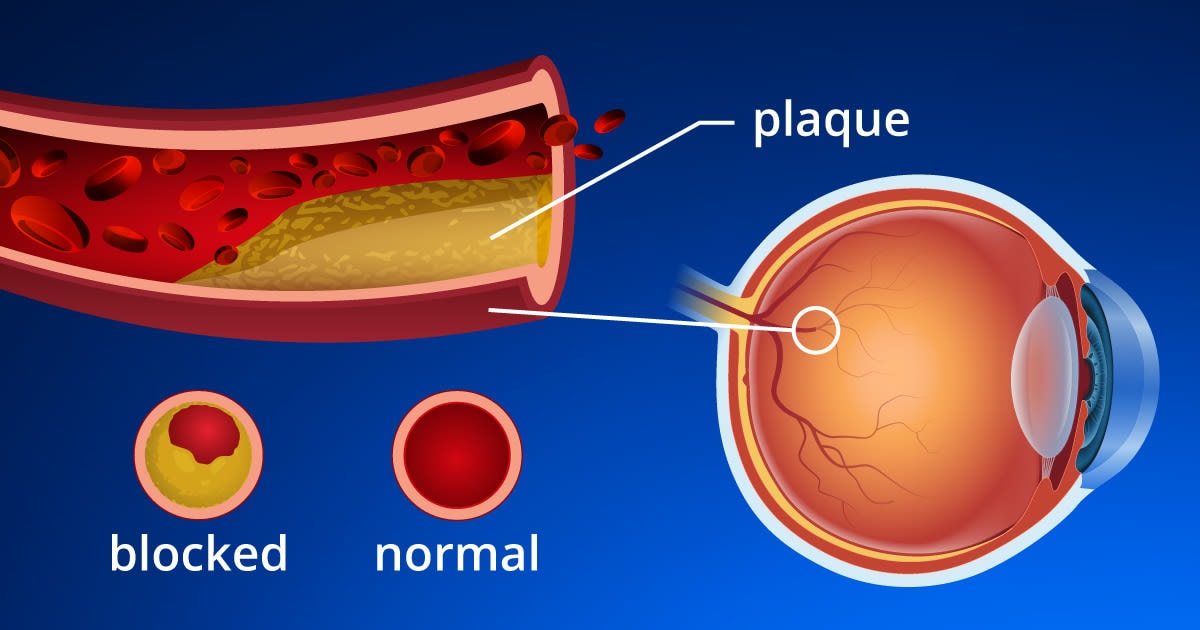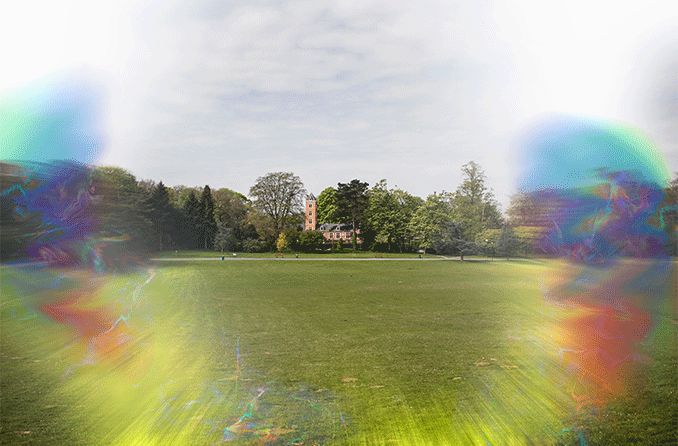What causes temporary blindness?
Temporary blindness can occur for a variety of reasons — from standing up too quickly to underlying conditions like brain tumors. If you don’t know why you are experiencing temporary blindness or other vision problems, it’s best to speak with your eye doctor as soon as you can.
Conditions that cause temporary blindness or sensations that only feel like temporary blindness include:
Ocular and visual migraines
Ocular migraines, sometimes called retinal migraines, describe a type of migraine that causes problems with vision. Temporary blindness and blind spots (particularly in the center of the visual field) are symptoms associated with an ocular migraine. In most cases, only one eye is affected.
An ocular migraine blind spot may start small and grow in size. One episode can last up to an hour. The condition is caused by blood vessel spasms or blood flow issues in the retina.

Visual migraines, sometimes called migraine auras, describe another type of migraine that may affect vision. Some disturbances you may experience include a blind spot in the center of your vision. You might see zigzag lines that seem to “shimmer.” Sometimes it might be dots and stars or flashes of light that resemble camera flashes.
These symptoms can last between 10 to 30 minutes and can lead to a headache. Visual migraines are more common than ocular migraines.
Photokeratitis
Photokeratitis (snow blindness) is a painful eye condition caused by overexposure to the sun’s ultraviolet (UV) rays. It is often described as a sunburn of the cornea.
Symptoms of photokeratitis include pain, redness, swelling and temporary vision loss. The vision loss associated with photokeratitis usually resolves within 24 to 48 hours after onset. Photokeratitis may also make it difficult to see colors clearly.
Fortunately, you can prevent photokeratitis by wearing proper eye protection when you are out in the sun. The most effective eyewear includes sunglasses, snow goggles or sports goggles that block 100% of UV rays. A pair of wraparound sunglasses or googles also block sunlight from entering the sides of the eyes. This style is highly recommended, particularly for those engaging in outdoor sports such as skiing or snowboarding.
Solar retinopathy
Like photokeratitis, solar retinopathy is caused by sun damage. This particular condition occurs if you look directly at the sun or into a solar eclipse. It affects the retina’s most sensitive part — the macula.
Solar retinopathy can damage the macula in a matter of seconds. Vision loss and blind spots are often temporary. But loss of vision can be irreversible if the damage is severe enough.
Preventing solar retinopathy and blindness (temporary or permanent) is easy. Wear proper UV protection when you’re in the sun. And never look directly at the sun.
Light sensitivity
The eyes are sensitive for everyone, but some may experience greater sensitivity — particularly to light. You can be so sensitive that exposure to certain levels of light can make you feel as though you have temporarily gone blind.
Some ways that light exposure can contribute to the feeling of temporary blindness include:
Digital eye strain caused by excessive exposure to digital displays (including computer and smartphone screens). Spending extended periods of time looking at screens at a close distance may cause temporary blur. To prevent this from happening, practice the 20-20-20 rule: Every 20 minutes, look at something 20 feet away for 20 seconds.
Sudden changes in light, such as opening curtains to brighten a very dark room. Experts claim that visually adapting to darkness can take up to 30 minutes. How long depends on the levels of brightness you had been exposed to.
Night blindness (nyctalopia), a condition that makes it difficult to see clearly at night or in low light settings. The condition can be uncomfortable and make a person feel as though they can’t see in the dark. This can be particularly troublesome for activities like driving at night.
SEE RELATED: Night driving glasses: Help or hoax?
Head trauma
Concussions and other head injuries can cause partial or complete temporary (or even permanent) blindness. The severity depends on what part of the head is injured and how serious the trauma is. A head injury may cause other visual symptoms, such as:
Difficulty moving the eyes
Dizziness
It’s best to see a doctor after any head injury. You should also contact an eye care professional immediately. This is especially true if you experience any vision problems following head trauma.
Orthostatic hypotension
Sometimes, standing up too quickly can cause you to experience a “head rush.” It may feel as though you are blacking out or losing your sense of sight, or you may feel very dizzy. This is called orthostatic hypotension, and it occurs when blood pressure drops suddenly after you stand or change posture.
Orthostatic hypotension is part of a category of temporary loss of vision called transient obscurations of vision (TOV), which only last for several seconds. If you experience this frequently, consult your doctor.
Giant cell arteritis
Giant cell arteritis (GCA) occurs when the blood vessels that carry blood away from the heart (called arteries) are inflamed or swollen. This reduces blood flow in the body. The specific arteries affected by GCA include those in the head, neck, upper body and arms.
The eyes also receive nourishment from these arteries. If blood flow to the eyes is interrupted, it can cause temporary vision loss that is sudden (and usually painless) in one or both eyes.
GCA can contribute to a condition called ischemic optic neuropathy (ION). ION is vision loss due to a lack of blood flow to the eyes.
Eye stroke
An eye stroke occurs when there is a blockage (occlusion) in the arteries or veins of the retina. Eye strokes can cause sudden vision loss. The severity of this vision loss depends on the location of the blockage. Vision can be recovered after an eye stroke, but eyes must be examined promptly for effective treatment.
There are several categories of eye stroke:

Central retinal artery occlusion (CRAO)
Central retinal artery occlusion (CRAO) – a blockage located in the main artery of the retina; normally affects one eye and can cause central vision loss
Central retinal vein occlusion (CRVO) – a blockage located in the main vein of the retina; can cause central vision loss
Branch retinal artery occlusion (BRAO) – a blockage in a smaller artery of the retina; can cause peripheral vision loss and, in some cases, central vision loss
Branch retinal vein occlusion (BRVO) – a blockage in a smaller vein of the retina; can cause peripheral vision loss and blind spots
Eye strokes are more common in people aged 60 and older. High cholesterol, high blood pressure, hardened arteries and other systemic problems can increase the risk of eye stroke.
Many who experience eye strokes will not exhibit any clear symptoms because they are often painless. But some may notice light sensitivity, decreased visual contrast or temporary blindness in one eye upon waking up. If you encounter any of these symptoms or believe you are having an eye stroke, see an eye doctor immediately to prevent further complications.
Papilledema
Optic nerve swelling, also known as papilledema, causes excess fluid to press on the nerves that send visual information to the brain. This increased pressure in or around the brain is called intracranial pressure. Papilledema can cause vision problems, so it’s important that it is addressed early on.
Those with papilledema may have symptoms such as nausea and vomiting, headaches, hearing problems or vision changes. These vision changes might be blurriness or double vision. Some may also experience temporary “blackouts” or feel as though they have temporary blindness.
Papilledema can be caused by many serious conditions. These include head trauma, brain tumors, bleeding of the brain (hemorrhage) and brain inflammation. Each of these conditions requires treatment and should be evaluated immediately. If left untreated for too long, papilledema can lead to permanent blindness.
Optic neuritis
Optic neuritis is inflammation of the optic nerve. It can cause problems such as vision loss in a single eye, color vision loss and visual field loss.
Optic neuritis may also be an early sign of multiple sclerosis (MS). MS is an autoimmune disorder that affects the central nervous system and disrupts how the body communicates with the brain. About 55% of people with MS experience optic neuritis. Many may experience temporary blindness as a result.
READ MORE: Eye symptoms commonly seen in multiple sclerosis
Amaurosis fugax: temporary blindness by another name
Some doctors prefer “amaurosis fugax” as a catch-all term to describe temporary vision loss in one or both eyes. Others only use this term when loss of vision is caused by blood vessel issues, such as stroke or blood clots.
You may see the terms “amaurosis fugax,” “temporary blindness” and “transient vision loss” used interchangeably. Don’t hesitate to ask why your doctor uses one or the other when describing your condition.
Temporary blindness vs. temporary blind spots
Like temporary blindness, temporary blind spots can occur with sudden light changes. They can also be caused by visual migraines and other issues. Unlike temporary blindness, temporary blind spots only affect portions of the visual field, not the entirety of it.
Whether you experience partial, full or just spots of temporary blindness will depend on the underlying cause.
Temporary blind spots can occur in both your frontal vision and your peripheral vision. Losing your peripheral vision temporarily is also called tunnel vision.
Is temporary blindness an emergency?
Total vision loss that happens quickly and unexpectedly should be treated as an emergency. Call 911 or your ophthalmologist immediately to receive a diagnosis and treatment.
Cases of temporary blindness that occur with migraine, after standing up too quickly or with sudden changes of light may not be as severe. Those that occur when a major underlying condition is also present are usually more serious.
In any case, it’s important to contact an eye doctor as soon as possible. An eye care professional can help determine why you are experiencing severe blurry vision, partial vision loss or blind spots.
Can temporary blindness be prevented?
Temporary blindness is not always preventable because it is often caused unexpectedly, by underlying conditions. But there are certain things you can do to protect your vision from related problems.
Consider the following guidelines:
Get a comprehensive eye exam once a year. Schedule an exam immediately if you experience unexplained vision problems.
Wear 100% UV protection to shield your eyes from harmful sunlight that can cause damage to your eyes.
Consider limiting screen time when you use digital screens. You might also consider blue light glasses.
Don’t stand up too quickly.
Avoid looking directly into the sun, and use precaution when observing a solar eclipse.
If you have a health problem that can affect your eyes — such as high cholesterol, high blood pressure or multiple sclerosis — strictly adhere to any advice provided by your doctor.
Never hesitate to contact an eye doctor if you experience vision problems — big or small.










